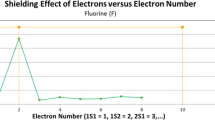Abstract
The ionization energy of one-electron ions can be calculated from a well-known equation that is based on quantum mechanics and on the Bohr model, but no theoretically justified equation is available for the calculation of the ionization energies of multi-electron ions. I report here simple empirical relationships between the ionization energies of one-, two- and three-electron ions of elements whose atomic numbers are Z, Z + 1 and Z + 2. On the basis of these relationships, an equation was constructed for the calculation of the ionization energies of two- and three-electron ions (IE2el(Z) and IE3el(Z), respectively) as a function of Z only:
where N = the number of electrons, i.e. 2 or 3. For N = 3, this equation is only valid when Z > N, being inaccurate for the neutral Li atom. Graphs of the difference between calculated and experimental values of the ionization energies as a function of Z reveal inaccurate experimental results that are impossible to detect by inspection of the ionization energy itself. On the basis of the present results, more accurate values can be predicted for these ionization energies. A striking example is the inaccuracy of the traditional handbook value of IE3el(Fe).




Similar content being viewed by others
References
Ancarani LU (2006) On the s-wave model of two-electron atoms. J Phys B At Mol Opt Phys 39:3309–3313
Barysz M, Flocke N, Karwowski J (2001) A comparison of different approximate two-component relativistic theories of many-electron systems: a case study of the ionization energies of two-electron ions. Acta Phys Pol A 99:631–641
Biémont E, Frémat Y, Quinet P (1999) Ionization potentials of atoms and ions from lithium to tin (Z = 50). At Data Nucl Data Tables 71:117–146
Chung KT (1991) Ionization potential of the lithiumlike 1s22s states from lithium to neon. Phys Rev A 44:5421–5433
Elo H (2007) A simple formula for calculating the ionization potential of two-electron ions. Naturwissenschaften 94:779–780
Howard IA, March NH (2005) Towards a differential equation for the non-relativistic ground-state electron density of the He-like sequence of atomic ions. Phys Rev A 71:042501/1–042501/5
Huang J, Jiang G, Zhao Q (2006) Ground-state ionization potentials for lithium through neon isoelectronic sequences with Z = 37–82. Chin Phys Lett 23:69–72
Jorge FE, Aboul Hosn HM (2001) Gaussian basis sets for isoelectronic series of the atoms He to Ne. Chem Phys 264:255–265
Karasiev V, Valderrama E, Ludeña EV (2000) Analysis of various quantum mechanical and DFT energy definitions. Application to atomic isoelectronic series. J Mol Struct (Theochem) 501–502:195–206
Lide DR (ed) (2006) CRC handbook of chemistry and physics, 87th edn. Taylor and Francis, Boca Raton, FL (internet version 2007, available at http://www.hbcpnetbase.com)
Nordling C, Österman J (2004) Physics handbook for science and engineering, 7th edn. Studentlitteratur, Lund
Serra P (2006) Comment on “Towards a differential equation for the nonrelativistic ground-state electron density of the He-like sequence of atomic ions”. Phys Rev A 74:016501/1–016501/2
Schrödinger E (1926a) Der stetige Übergang von der Mikro- zur Makromechanik. Naturwissenschaften 14:664–666
Schrödinger E (1926b) An undulatory theory of the mechanics of atoms and molecules. Phys Rev 28:1049–1070
Schrödinger E (1929) Die Erfassung der Quantengesetze durch kontinuierliche Funktionen. Naturwissenschaften 17:486–489
Schrödinger E (1935a) Die gegenwärtige Situation in der Quantenmechanik. Naturwissenschaften 23:807–812
Schrödinger E (1935b) Die gegenwärtige Situation in der Quantenmechanik. Naturwissenschaften 23:823–828
Schrödinger E (1935c) Die gegenwärtige Situation in der Quantenmechanik. Naturwissenschaften 23:844–849
Tanner G, Richter K, Rost J-M (2000) The theory of two-electron atoms: between ground state and complete fragmentation. Rev Mod Phys 72:497–544
Author information
Authors and Affiliations
Corresponding author
Rights and permissions
About this article
Cite this article
Elo, H. Simple relationships between the ionization energies of one-, two- and three-electron ions of consecutive elements. Naturwissenschaften 95, 399–402 (2008). https://doi.org/10.1007/s00114-007-0338-8
Received:
Revised:
Accepted:
Published:
Issue Date:
DOI: https://doi.org/10.1007/s00114-007-0338-8




